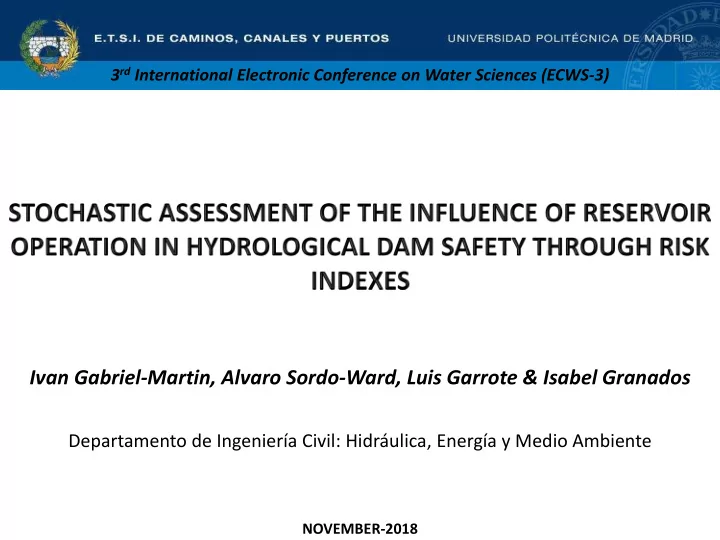

3 rd International Electronic Conference on Water Sciences (ECWS-3) Ivan Gabriel-Martin, Alvaro Sordo-Ward, Luis Garrote & Isabel Granados Departamento de Ingeniería Civil: Hidráulica, Energía y Medio Ambiente NOVEMBER-2018
Introduction Materials and Methods Results and Discussion Conclusions Introduction • Failure of Large Dams is a concern in many countries. • Dam risk assesment has evolved lately. Importance of initial reservoir level. • Evolution of stochastic methodologies. PROPOSAL STOCHASTIC INITIAL RESERVOIR ECONOMIC METHODS LEVEL ASSESMENT DAM AND DOWNSTREAM SAFETY 1/4
Introduction Materials and Methods Results and Discussion Conclusions Materials and Methods • Generation of synthetic inflow hydrographs. • Stochastic initial reservoir level assignation. • Reservoir-Dam system routing. • Risk-Index analysis. Applied to a concrete gravity multipurpose dam Reservoir Levels Maximum Outflow Capacity at Maximum Normal Level (MNL) (m 3 /s) (m.a.s.l) Maximum Normal Level (MNL) 386 Gated-spillway 2200 Design flood level (DFL) 387 Crest of dam (COD) 388 Bottom outlet 57 2/4
Introduction Materials and Methods Results and Discussion Conclusions Results and Discussion Hydrograph generation Damage Curves 12 60 10 50 6 euros) 6 euros) 8 40 30 6 Damage cost (10 Damage cost (10 20 4 10 2 0 0 386 386.5 387 387.5 388 388.5 389 0 500 1000 1500 2000 Maximum reservoir level (m.a.s.l.) 3 /s) Maximum outflow (m Risk Index Initial Reservoir Level OCT NOV DEC 1 1 1 Scenario 1 0.5 0.5 0.5 I R (10 3 euros) 0 0 0 200 400 600 800 200 400 600 800 200 400 600 800 JAN FEB MAR 1445.6 1 1 1 0.5 0.5 0.5 Scenario 2 0 0 0 200 400 600 800 200 400 600 800 200 400 600 800 Cumulative frequency I R (10 3 euros) APR MAY JUN 1 1 1 0.5 0.5 0.5 980.5 0 0 0 200 400 600 800 200 400 600 800 200 400 600 800 Scenario 3 JUL AUG SEP 1 1 1 I R (10 3 euros) 0.5 0.5 0.5 0 0 0 200 400 600 800 200 400 600 800 200 400 600 800 93.0 3 Initial Volume in the Reservoir (hm ) 3/4
Introduction Materials and Methods Results and Discussion Conclusions Conclusions • For the case study, considering the fluctuation of initial reservoir level provided a more realistic assessment of hydrological dam and downstream safety. • The global risk index reduced its value up to 93 % if variable initial reservoir level is accounted, from 1445.6 x10 3 to a value of 93.0 x10 3 euros in the case study. Acknowledgements The authors would like to thank the funds from Fundación José Entrecanales Ibarra in the framework of the Program “Support program for research purposes”. The authors acknowledge the computer resources and technical assistance provided by the Centro de Supercomputación y Visualización de Madrid (CeSViMa) and the funds from Universidad Politécnica de Madrid in the framework of their Program “Ayudas para contratos predoctorales para la realización del doctorado en sus escuelas, facultad, centro e institutos de I+D+i” and in the framework of their Program “Ayudas a dirigidas a jóvenes investigadores doctores para fortalecer sus planes de investigación”. Main References Gabriel-Martin, I.; Sordo-Ward, A.; Garrote, L.; G. Castillo, L. Influence of initial reservoir level and gate failure in dam safety analysis. Stochastic approach. J. Hydrol. 2017 , 550 , 669-684, https://doi.org/10.1016/j.jhydrol.2017.05.032 Sordo-Ward, A.; Gabriel-Martin, I.; Bianucci, P.; Garrote, L. A Parametric Flood Control Method for Dams with Gate-Controlled Spillways. Water 2017 , 9 , 237. https://doi.org/10.3390/w9040237 4/4
Recommend
More recommend